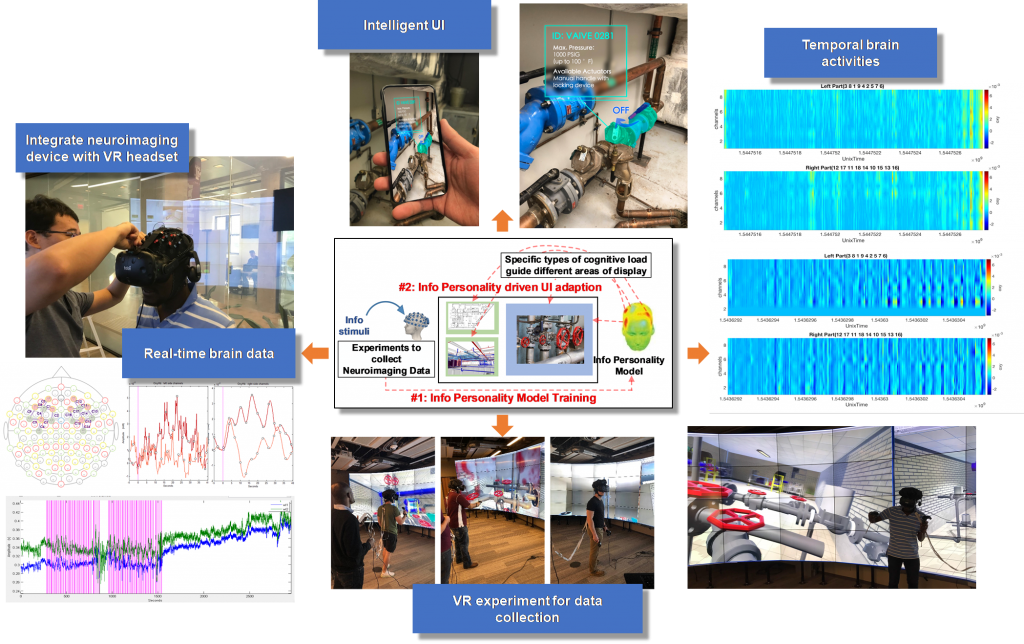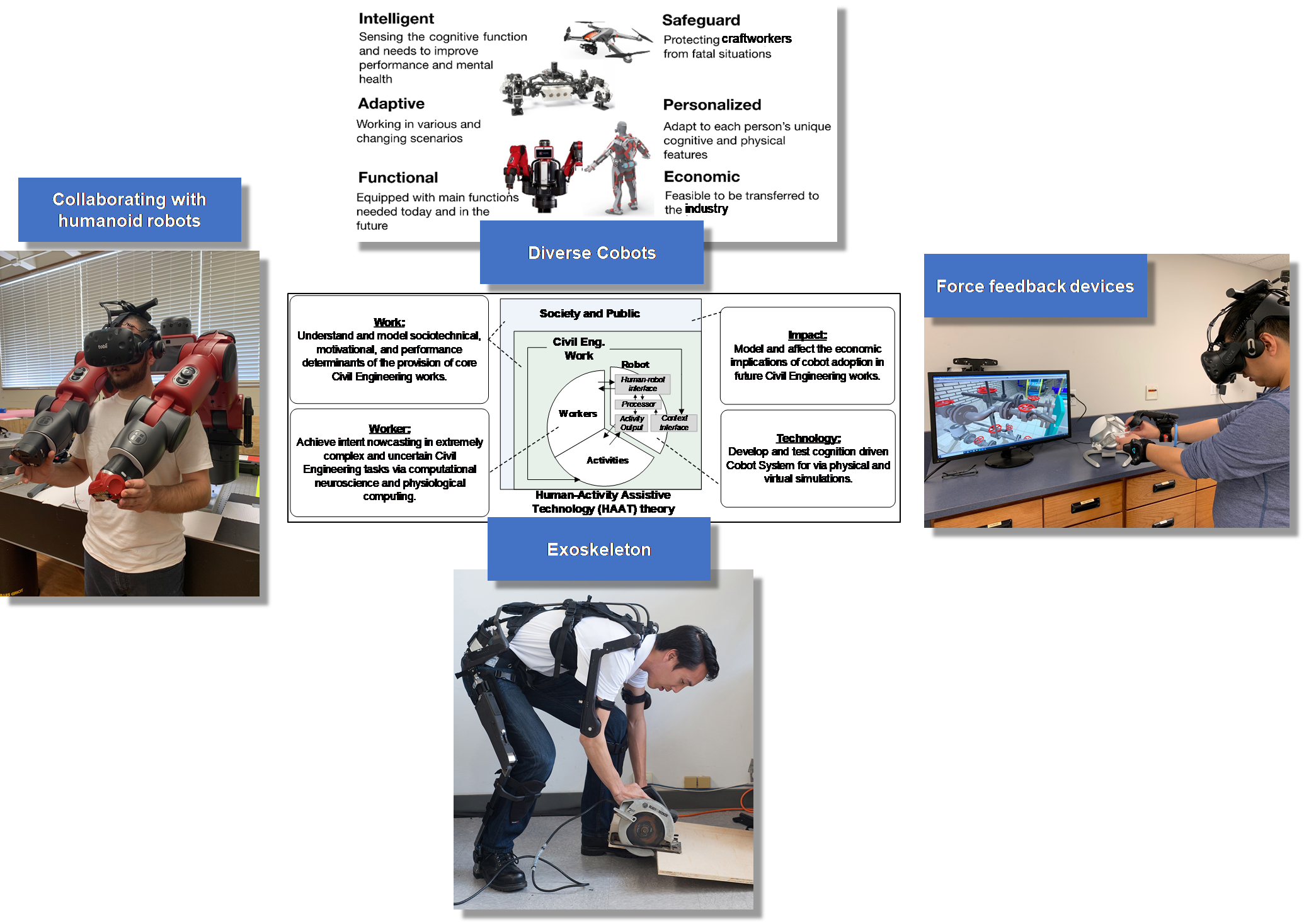ABOUT ICIC
The Informatics, Cobots, and Intelligent Construction (ICIC) Lab aims at the development and test of the next generation Intelligent Information Systems (IIS) and Intelligent Physical Systems (IPS) for the design, engineering, construction and operations of built environments (e.g., buildings, industrial facilities, and smart transportation systems etc.). Specifically, we focus on augmenting human cognitive and physical capabilities and developing a 21st century data-capable civil engineering workforce via Intelligent Cognitive Assistants (ICAs) and Collaborative Robots (Cobots). The accomplishment of our goal relies on the understanding of (1) the fundamental mechanisms of human cognition in the context of civil engineering works; and (2) the embodied systems that enhance civil engineering workers’ cognitive and physical capabilities.
Active Projects
 |
“Tactile Learning for Robotic Dexterity”. September 2024 – March 2026, PI |
 |
“SCC-IRG Track 1: Strengthening Elderly Mobility in Urban Landscapes: Towards Age-Inclusive and Equitable Communities“. September 2024 – August 2026, Co-PI |
 |
“Human-Machine Sensory Sharing for Swift Trust in Autonomy”. December 2022 – November 2025, PI |
 |
“FW-HTF-R/Collaborative Research: Human-Robot Sensory Transfer for Worker Productivity, Training, and Quality of Life in Remote Undersea Inspection and Construction Tasks“. September 2021 – August 2025, PI |
|
“SearchAR: User Centered Adaptive Augmented Reality for Search and Rescue“. June 2021 – May 2024,PI |
 |
“NRI: INT: Collaborative Research: ForceBot: Customizable Robotic Platform for Body-Scale Physical Interaction Simulation in Virtual Reality“. Oct 2020 – Sep 2024, PI |
Completed Projects
 |
“B2: Learning Environments with Augmentation and Robotics for Next-gen Emergency Responders (LEARNER) “. September 2020 – August 2022, Co-PI |
 |
“Sensory Manipulation as a Countermeasure to Robot Teleoperation Delays “. April 2021 – December 2022, PI The National Astronautic and Space Administration (NASA). |
|
“Cognition-driven Display for Navigation Activities (Cog-DNA): Personalized Spatial Information System Based on Information Personality of Firefighters”. June 2018 – May 2022,PI |
 |
“HDBE: Collaborative Research: Personalized Systems for Wayfinding for First Responders“. June 2018 – May 2022, PI |
 |
“Convergence Accelerator Phase I (RAISE): Learning Environments with Advanced Robotics for Next-Generation Emergency Responders (LEARNER)“. September 2019 – May 2021, Co-PI |
 |
“RAPID: High-Frequency Data Collection for Human Mobility Prediction during COVID-19“. May 2020 – April 2021, PI |
 |
“IBSS: Participatory Ensemble Modeling to Study the Multiscale Social and Behavioral Dynamics“. August 2014 – January 2019, Co-PI |
 |
“BIM-enabled Augmented Reality for Intelligent Building Inspection“. March 2020 – March 2021,PI |
 |
“Hostile Intent Prediction based on Gaze Movement Trajectory in Indoor Navigation”. May 2018 – April 2019, PI |
 |
“Enhancing Flood Resiliency in an Underserved Neighborhood”. Oct 2017 – Sep 2018, Co-PI |
 |
“Optimize Road Preventive Maintenance Decisions based on Running Vehicles’ Vibration Data”. May 2018 – October 2019, PI Smart Phone App for Road Damage Detection based on Vehicle Vibrations: CLICK HERE |
 |
“Building Information Modeling Supported Building Life Cycle Management: On the Edge of Total Information Management”. Sep 2014 – Aug 2015, Co-PI |
 |
“Enhance Project Controls by Quantitative Approaches”. April 2014 – August 2017, PI |
 |
“A Cloud-Based Benchmarking Tool for Building Information Modeling (BIM). September 2014 – August 2015, PI |
THEME 1: Cognition-Driven Intelligent Information System for Complex Civil Engineering Works
In many civil engineering tasks, attention, not data, is the scarce resource. While modern information technologies (e.g., IoTs) and visualization methods (e.g., VR, AR) make the generation and communication of large amounts of real-time information about built environments much easier, it also brings a new challenge: information overload. The well-proven Miller’s Law shows that in one-dimension judgement tasks (such as temporarily remembering a phone number), an average person can only hold and process 2 to 3 bits of information at one time. The apparent gap between the enormous information processing needs in civil engineering works and the limited processing capacity will significantly affect the productivity, safety and quality of work. This theme of research investigates a cognition-driven, personalized and adaptive IIS that can customizes the format and content of the information to the civil engineering professionals, by a real-time monitoring of the neurophysiological signals.

Figure 1. Cognition-driven Intelligent Information System (click for enlarged picture)
THEME 2: Human-Robot Collaboration in Civil Engineering
Human-robot collaboration has been tested in various industries including manufacturing, healthcare, and smart agriculture. This theme of research focuses on identifying the new methods, requirements, opportunities and challenges of Collaborative Robots (Cobot) in Civil Engineering. We envision that the future Cobot in Civil Engineering should enable solutions in which workers directly interact with robots, and have the potential to dramatically transform the future of Civil Engineering works. Cobots have the potential to: 1) provide levels of physical assistance, augmentation, or autonomy needed to support engineering operations; 2) withstand hazardous environments; 3) communicate, integrate, and act on critical/relevant information to and from various sources; 4) sense and adapt to workers’ changing capabilities and actions; 5) reduce physical, cognitive, and environmental stressors, thereby enhancing their quality of life and career longevity; and 6) improve response efficiency, lower injuries and fatalities, and reduce economic losses. To fully realize and achieve this potential, critical fundamental research is needed to enable cobots to effectively interact with and augment Civil Engineering workers’ performance and to determine behavioral and socioeconomic impacts of cobots in future Civil Engineering works.

Figure 2. Collaborative Robots (Cobots) in Future Civil Engineering (click for enlarged picture)
THEME 3: Self-Adaptive Cyber-Physical Systems for Construction
We’re on the cusp of the Fourth Industrial Revolution, or Industry 4.0. The hallmark of Industry 4.0 is the widely use of Cyber-Physical Systems (CPS), i.e., engineered systems that are built from, and depend upon, the seamless integration of computation and physical components. According to Cisco, the number of connected devices on Cyber-Physical Systems (CPS) will exceed 50 billion by 2020, fundamentally changing the way we live and work. CPS has been well tested and validated in various mature industrial applications, such as manufacturing, where workplace can be explicitly defined and workflow is highly standardized and automated. However, our knowledge about CPS at less-structured and less-controlled industrial workplaces is still primitive. Many industrial applications, such as infrastructure construction (e.g., powerplant projects), are constrained by the unpredictable behaviors of human agents, changing workflows, open and less-controlled work environments, complex and evolving workplace, and non-repetitive procedures. This theme of research aims to investigate a highly dynamic CPS that has a broader adaptability, scalability, usability (reusability) and economics in the less explored construction industry.

Figure 3. Self-adaptive CPS for construction workplaces (click for enlarged picture)
